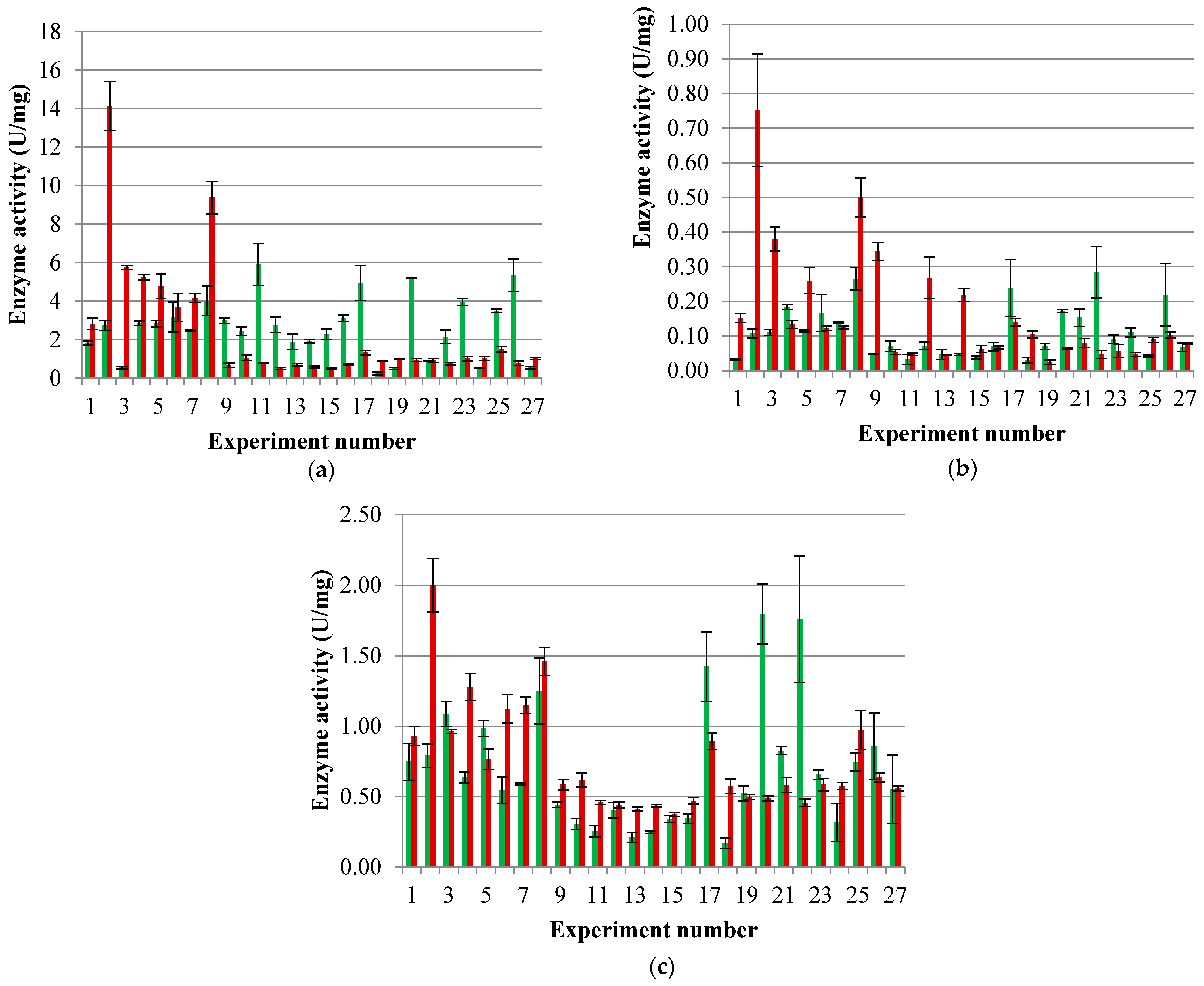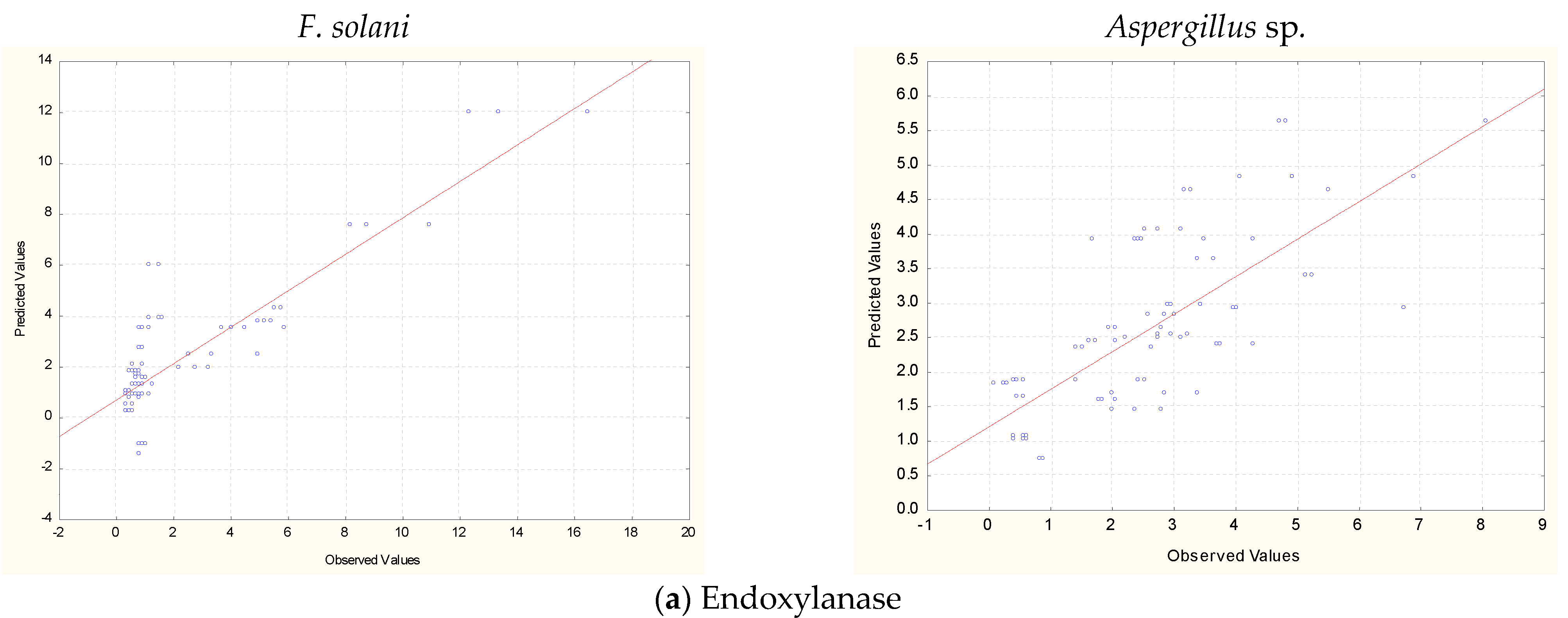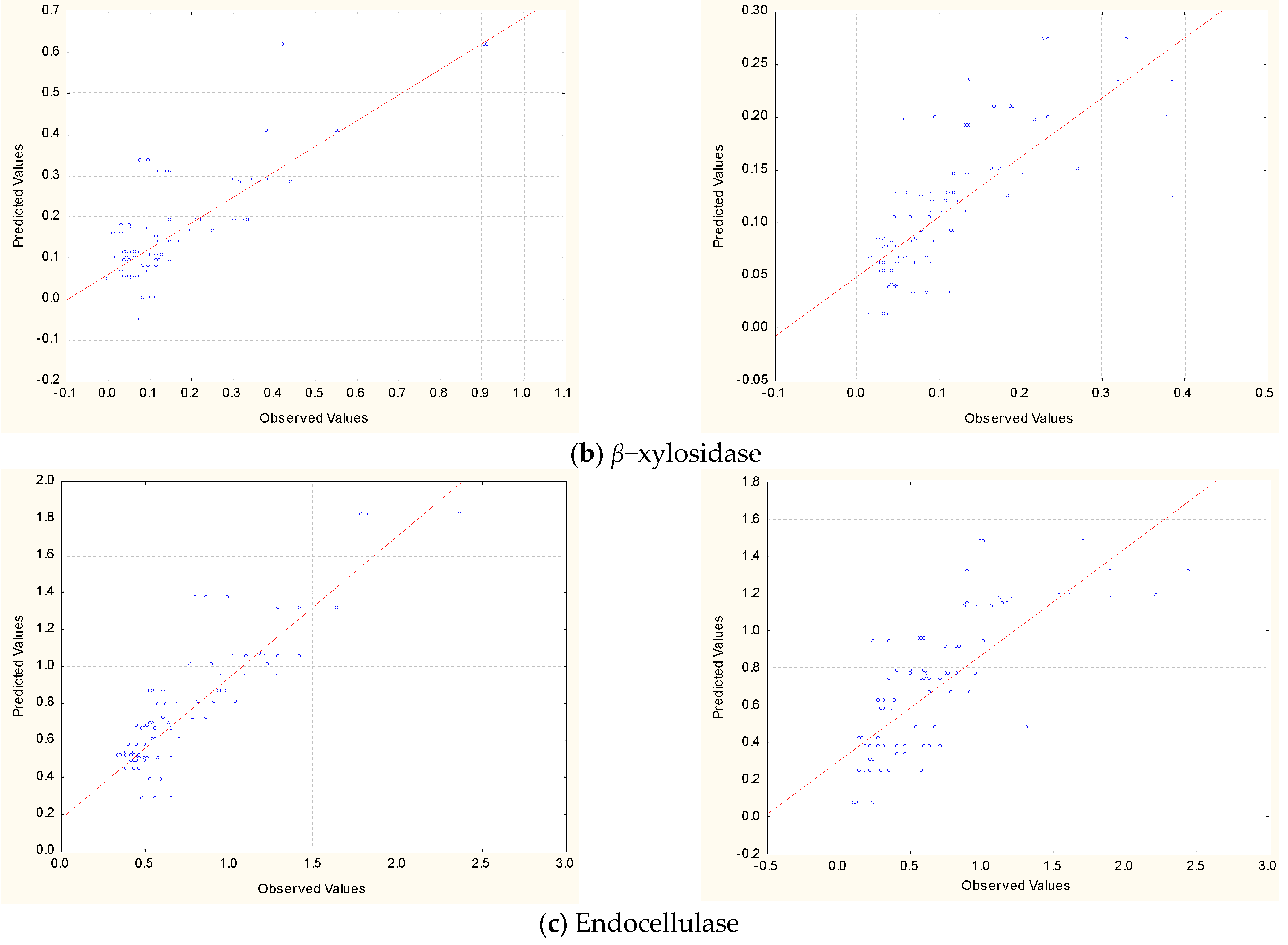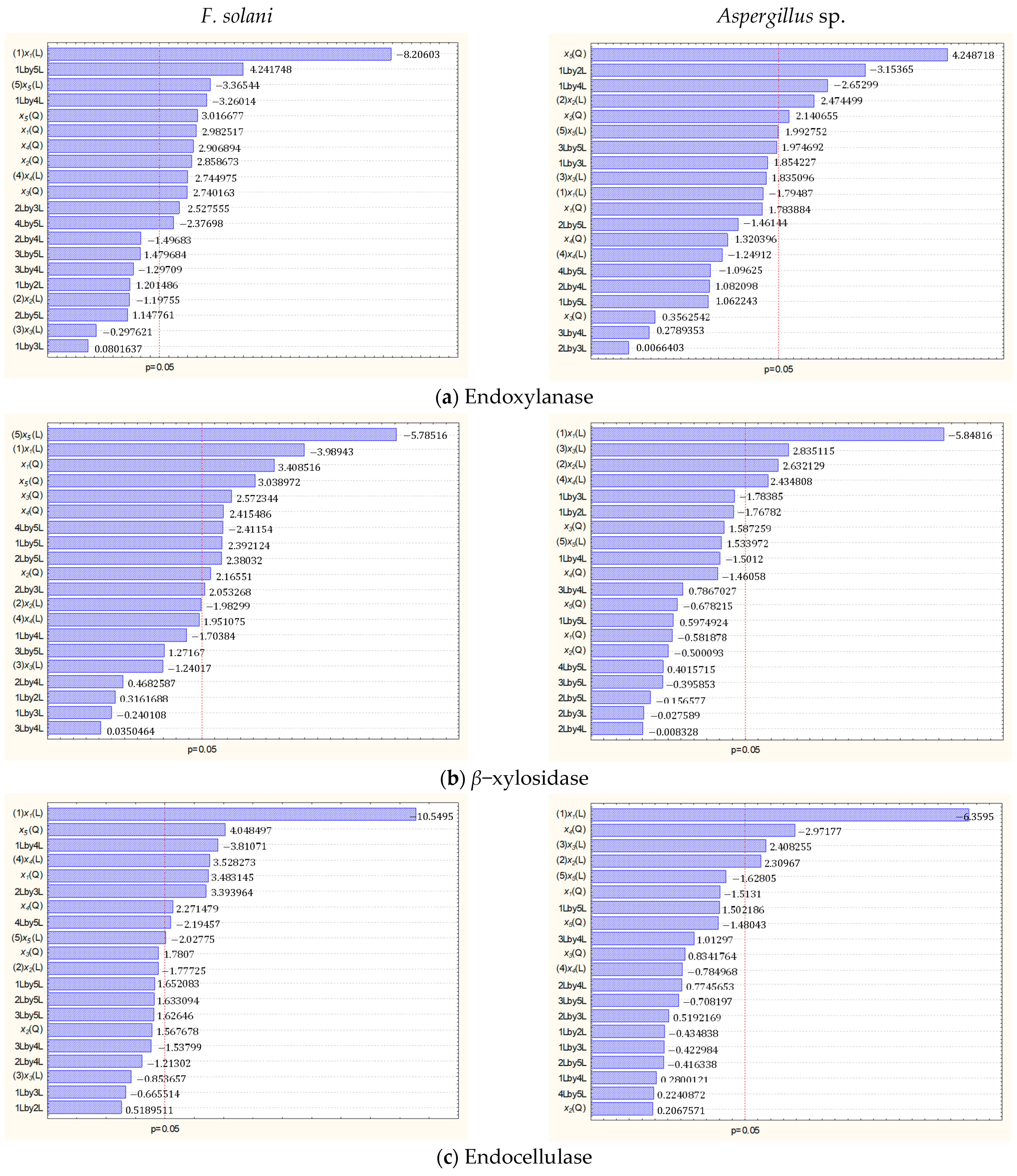Comparative Study of the Extracellular Holocellulolytic Activity of Fusarium solani and Aspergillus sp. in Corn Stover
Abstract
1. Introduction
2. Materials and Methods
2.1. Biological Material
2.2. Fungus Molecular Identification
2.3. Experimental Design
2.4. Inoculum Preparation
2.5. Xylanase Production by Fermentation
2.6. Extraction of Holocellulolytic Enzyme
2.7. Holocellulolytic Enzyme Assays
2.7.1. Endo-β-1,4-Xylanase, Endocellulase, and β-1,4-Xylosidase Activities Assays
2.7.2. Extracellular Protein Quantification
2.8. Optimization of Fermentation Conditions for Xylanase Production
3. Results
3.1. Holocellulolytic Activity of F. solani and Aspergillus sp. in BW Experiments
3.2. Predicted and Experimental Data
3.3. Effect of Factors on Holocellulase Production
3.4. Optimization of Holocellulase Production
3.5. Verification of Optimal Conditions to Produce of Holocellulases
4. Discussion
5. Conclusions
Supplementary Materials
Author Contributions
Funding
Institutional Review Board Statement
Informed Consent Statement
Data Availability Statement
Acknowledgments
Conflicts of Interest
References
- Barrera-Guzmán, L.A.; Cadena-Iñiguez, J.; Ramírez-Ojeda, G. Implementation of stubble in agricultural production: A review. Agro-Prod. 2022, IX, 185–193. [Google Scholar] [CrossRef]
- Kwiatkowski, C.A.; Harasim, E.; Haliniarz, M.; Gawęda, D.; Misztal-Majewska, B.; Chojnacka, S. Chemical composition of stubble crop biomass depending on a crop plant species and tillage system. J. Elem. 2019, 24, 1371–1381. [Google Scholar] [CrossRef]
- Morales-Máximo, C.N.; López-Sosa, L.B.; Rutiaga-Quiñones, J.G.; Corral-Huacuz, J.C.; Aguilera Mandujano, A.; Pintor-Ibarra, L.F.; López-Miranda, A.; Delgado Domínguez, S.N.; Rodríguez Magallón, M.d.C.; Morales-Máximo, M. Characterization of agricultural residues of Zea mays for their application as solid biofuel: Case study in San Francisco Pichátaro, Michoacán, México. Energies 2022, 15, 6870. [Google Scholar] [CrossRef]
- Garg, G.; Mahajan, R.; Kaur, A.; Sharma, J. Xylanase production using agro-residue in solid-state fermentation from Bacillus pumilus ASH for biodelignification of wheat straw pulp. Biodegradation 2011, 22, 1143–1154. [Google Scholar] [CrossRef]
- Martínez-Pacheco, M.M.; Flores-García, A.; Zamudio-Jaramillo, M.A.; Chávez-Parga, M.C.; Alvarez-Navarrete, M. Production of extracellular xylanase from a wild isolate of Fusarium solani. Rev. Argent. Microbiol. 2020, 52, 328–337. [Google Scholar] [CrossRef]
- Liu, W.; Shi, P.; Chen, Q.; Yang, P.; Wang, G.; Wang, Y.; Luo, H.; Yao, B. Gene cloning, overexpression, and characterization of a xylanase from Penicillium sp. CGMCC 1669. Appl. Biochem. Biotechnol. 2010, 162, 1–12. [Google Scholar] [CrossRef]
- Andrade-Hoyos, P.; Rivera-Jiménez, M.N.; Landero-Valenzuela, N.; Silva-Rojas, H.V.; Martínez-Salgado, S.J.; Romero-Arenas, O. Ecological and biological benefits of the cosmopolitan fungus Trichoderma spp. in agriculture: A perspective in the Mexican countryside. Rev. Argent. Microbiol. 2023, 55, 366–377. [Google Scholar] [CrossRef]
- Kumar, R.; Verma, D.; Sharma, S.; Satyanarayana, T. Applicability of fungal xylanases in food biotechnology. In Fungi and Fungal Products in Human Welfare and Biotechnology; Satyanarayana, T., Deshmukh, S.K., Eds.; Springer: Singapore, 2023. [Google Scholar] [CrossRef]
- Saldarriaga-Hernández, S.; Velasco-Ayala, C.; Leal-Isla Flores, P.; Rostro-Alanis, M.J.; Parra-Saldivar, R.; Iqbal, H.M.N.; Carrillo-Nieves, D. Biotransformation of lignocellulosic biomass into industrially relevant products with the aid of fungi-derived lignocellulolytic enzymes. Int. J. Biol. Macromol. 2020, 161, 1099–1116. [Google Scholar] [CrossRef] [PubMed]
- Carrillo-Nieves, D.; Saldarriaga-Hernández, S.; Gutiérrez-Soto, G.; Rostro-Alanis, M.; Hernández-Luna, C.; Alvarez, A.J.; Iqbal, H.M.N.; Parra-Saldívar, R. Biotransformation of agro-industrial waste to produce lignocellulolytic enzymes and bioethanol with a zero waste. Biomass Convers. Biorefin 2022, 12, 253–264. [Google Scholar] [CrossRef]
- Astorga-Trejo, R.; Fonseca-Peralta, H.M.; Beltrán-Arredondo, L.I.; Castro-Martínez, C. Use of corn stover for the production of 2G bioethanol, enzymes and xylitol under a biorefinery concept. World Acad. Sci. Eng. Technol. 2022, 16, 9. Available online: https://publications.waset.org/pdf/10012662. (accessed on 13 June 2023).
- Howard, R.L.; Abotsi, E.; Jansen van Rensburg, E.L.; Howard, S. Lignocellulose biotechnology: Issues of bioconversion and enzyme production. Afr. J. Biotechnol. 2003, 2, 602–619. [Google Scholar] [CrossRef]
- Narayanan Narayanan, M.; Sameh Samir, A.; El-Sheekh, M. A comprehensive review on the potential of microbial enzymes in multipollutant bioremediation: Mechanisms, challenges, and future prospects. J. Environ. Manag. 2023, 334, 117532. [Google Scholar] [CrossRef]
- Marinho, G.O.; Nogueira, E.A.; Machado Pasin, T.; Brito de Oliveira, T.; Bretas Roa, J.P.; Nelson, D.L.; Benassi, V.M. An environmentally safe production of xylanases by Fusarium sp. EA 1.3.1 using agroindustrial residues: Biochemical characterization and potential applications. Asian J. Biochem. Gen. Mol. Biol. 2023, 14, 11–26. [Google Scholar] [CrossRef]
- Kaur, D.; Joshi, A.; Sharma, V.; Batra, N.; Sharma, A.K. An insight into microbial sources, classification, and industrial applications of xylanases: A rapid review. Biotechnol. Appl. Biochem. 2023, 70, 1489–1503. [Google Scholar] [CrossRef]
- Zhao, X.; Chai, J.; Wang, F.; Jia, Y. Optimization of submerged culture parameters of the aphid pathogenic fungus Fusarium equiseti based on sporulation and mycelial biomass. Microorganisms 2023, 11, 190. [Google Scholar] [CrossRef]
- Alvarez-Navarrete, M.; Reyna López, G.E.; Flores García, A.; López Gómez, R.; Martínez-Pacheco, M.M. Selection and molecular identification of fungal isolates that produce xylanolytic enzymes. Genet. Mol. Res. 2015, 14, 8100–8116. [Google Scholar] [CrossRef]
- Lin, R.C.; Ding, Z.S.; Li, L.B.; Kuang, T.Y. A rapid and efficient DNA minipreparation suitable for screening transgenic plants. Plant Mol. Biol. Report. 2001, 19, 379. Available online: https://link.springer.com/content/pdf/10.1007/BF02772839.pdf. (accessed on 1 September 2023). [CrossRef]
- Carbone, I.; Kohn, L.M. A method for designing primer sets for speciation studies in filamentous ascomycetes. Mycologia 1999, 91, 553–556. [Google Scholar] [CrossRef]
- Montgomery, D.C.; Runger, G.C. Applied Statistics and Probability for Engineers; John Wiley & Sons: New York, NY, USA, 1996. [Google Scholar]
- Bailey, M.J.; Biely, P.; Poutanen, K. Interlaboratory testing of methods for assay of xylanase activity. J. Biotechnol. 1992, 23, 257–271. [Google Scholar] [CrossRef]
- Ghose, T.K. Measurement of cellulase activities. Pure Appl. Chem. 1987, 59, 257–268. [Google Scholar] [CrossRef]
- Kristufek, D.; Zeilinger, S.; Kubicek, C.P. Regulation of β-xylosidase formation by xylose in Trichoderma reesei. Appl. Microbiol. Biotechnol. 1995, 42, 713–717. [Google Scholar] [CrossRef]
- Miller, G.L. Use of DNS for determination of reducing sugar. Anal. Chem. 1959, 31, 426–428. [Google Scholar] [CrossRef]
- Lowry, O.H.; Rosenbrough, N.J.; Farr, A.L.; Randall, R.J. Protein measurement with the Folin phenol reagent. J. Bio. Chem. 1951, 193, 265–275. [Google Scholar] [CrossRef]
- Derringer, G.; Suich, R. Simultaneous optimization of several response variables. J. Qual. Technol. 1980, 12, 214–219. [Google Scholar] [CrossRef]
- Cebrián, M.; Ibarruri, J. Filamentous fungi processing by solid-state fermentation. In Current Developments in Biotechnology and Bioengineering; Filamentous Fungi Biorefinery; Elsevier: Amsterdam, The Netherlands, 2023; pp. 251–292. [Google Scholar] [CrossRef]
- Gupta, V.K.; Gaur, R.; Yadava, S.K.; Darmwal, N.S. Optimization of xylanase production from free and immobilized cells of Fusarium solani F7. Bioresources 2009, 4, 932–945. Available online: https://bioresources.cnr.ncsu.edu/BioRes_04/BioRes_04_3_0932_Gupta_GYD_Opt_Xylanase_Prodn_Fee_Immob_Cells_434.pdf (accessed on 7 April 2023). [CrossRef]
- Obruca, S.; Marova, I.; Matouskova, P.; Haronikova, A.; Lichnova, A. Production of lignocellulose-degrading enzymes employing Fusarium solani F-552. Folia Microbiol. 2012, 57, 221–227. [Google Scholar] [CrossRef]
- Bakri, Y.; Jawhar, M.; Arabi, M.I.E. Molecular and xylanolytic variation identified among isolates of Fusarium species. J. Plant Biol. Res. 2012, 1, 51–56. Available online: http://www.inast.otg/jpbr.html (accessed on 7 April 2023).
- Agustini, L.; Efiyanti, L.; Faulina, S.A.; Santoso, E. Isolation and characterization of cellulase- and xylanase-producing microbes isolated from tropical forests in Java and Sumatra. Int. J. Environ. Bioener. 2012, 3, 154–167. Available online: https://modernscientificpress.com/Journals/ViewArticle.aspx?gkN1Z6Pb60HNQPymfPQlZM2QzBATUXAyEhQZJVFyB5jxACLp2DSn8X3BE2yz4Gxm (accessed on 7 April 2023).
- Lemos, J.L.S.; Fontes, M.C.A.; Pereira, N., Jr. Xylanase production by Aspergillus awamori in solid-state fermentation and influence of different nitrogen sources. Appl. Biochem. Biotechnol. 2001, 91–93, 681–690. [Google Scholar] [CrossRef]
- Chipeta, Z.A.; du Preez, J.C.; Szakacs, G.; Christopher, L. Xylanase production by fungal strains on spent sulfite liquor. Appl. Microbiol. Biotechnol. 2005, 69, 71–78. [Google Scholar] [CrossRef] [PubMed]
- Padmavathi, T.; Kavya, V. Isolation, identification and optimization of xylanase enzyme produced by Aspergillus niger under submerged fermentation. J. Microbiol. Biotechnol. Res. 2011, 1, 137–147. Available online: http://scholarsresearchlibrary.com/archive.html (accessed on 8 April 2023).
- Sridevi, B.; Charya, M.A.S. Isolation, identification, and screening of potential cellulase-free xylanase producing fungi. Afr. J. Biotechnol. 2011, 10, 4624–4630. [Google Scholar]
- Kheng, P.P.; Ibrahim, C.O. Xylanase production by a local fungal isolate, Aspergillus niger USM AI 1 via solid state fermentation using palm kernel cake (PKC) as substrate. Songklanakarin J. Sci. Technol. 2005, 27, 325–336. Available online: https://www.thaiscience.info/Journals/Article/SONG/10462555.pdf (accessed on 8 April 2023).
- Shah, A.R.; Madamwar, D. Xylanase production under solid-state fermentation and its characterization by an isolated strain of Aspergillus foetidus in India. World J. Microbiol. Biotechnol. 2005, 21, 233–243. [Google Scholar] [CrossRef]
- Xu, Y.-X.; Li, Y.-L.; Xu, S.-C.; Liu, Y.; Wang, X.; Tang, J.-W. Improvement of xylanase production by Aspergillus niger XY-1 using response surface methodology for optimizing the medium composition. J. Zhejiang Univ. Sci. B 2008, 9, 558–566. [Google Scholar] [CrossRef]
- Liu, C.; Sun, Z.-T.; Du, J.-H.; Wang, J. Response surface optimization of fermentation conditions for producing xylanase by Aspergillus niger SL-05. J. Ind. Microbiol. Biotechnol. 2008, 35, 703–711. [Google Scholar] [CrossRef]
- Maciel, G.M.; Vandenberghe, L.P.S.; Haminiuk, C.W.I.; Fendrich, R.C.; Bianca, B.E.D.; Brandalize, T.Q.S.; Pandey, A.; Soccol, C.R. Xylanase production by Aspergillus niger LPB 326 in solid-state fermentation using statistical experimental design. Food Technol. Biotechnol. 2008, 46, 183–189. Available online: https://ftb.com.hr/images/pdfarticles/2008/April-June/46-183.pdf (accessed on 8 April 2023).
- Kavya, V.; Padmavathi, T. Optimization of growth conditions for xylanase production by Aspergillus niger in solid state fermentation. Pol. J. Microbiol. 2009, 58, 125–130. Available online: http://www.pjmonline.org/wp-content/uploads/archive/vol5822009125.pdf (accessed on 16 April 2023). [PubMed]
- Regalado, C.; Vázquez-Obregón, I.; García-Almendárez, B.E.; Domínguez-Domínguez, J.; Aguilera-Barreyro, A.; Amaro-Reyes, A. Xylanolytic enzymes production by Aspergillus niger GS1 from solid state fermentation on corn stover and their effect on ruminal digestibility. Electronic J. Biotechnol. 2011, 14, 9. [Google Scholar] [CrossRef][Green Version]
- Silvestro, L.B.; Stenglein, S.A.; Forjan, H.; Dinolfo, M.I.; Arambarri, A.M.; Manso, L.; Moreno, M.V. Occurrence and distribution of soil Fusarium species under wheat crop in zero tillage. Span. J. Agric. Res. 2013, 11, 72–79. [Google Scholar] [CrossRef]
- González-Rentería, S.M.; Soto-Cruz, N.O.; Rutiaga-Quiñones, O.M.; Medrano-Roldán, H.; Rutiaga-Quiñones, J.G.; López-Miranda, J. Optimización del proceso de hidrólisis enzimática de una mezcla de pajas de frijol de cuatro variedades (Pinto villa, Pinto saltillo, Pinto mestizo y Flor de mayo). Rev. Mex. Ing. Quim. 2011, 10, 17–28. [Google Scholar]
- Moctezuma-Zárate, M.; Vargas-Morales, J.; Cárdenas-González, J.; Martínez-Juárez, V.; Acosta-Rodríguez, I. Induction of extracellular lytic enzymes by Fusarium solani. Adv. Microbiol. 2013, 3, 24–30. Available online: https://www.scielo.org.mx/pdf/rmiq/v10n1/v10n1a3.pdf (accessed on 16 April 2023). [CrossRef]
- Bakri, Y.; Jawhar, M.; Arabi, M.I.E. Xylanase production by Fusarium solani in solid state fermentation. Res. Biotechnol. 2013, 4, 31–37. [Google Scholar]
- Ellatif, S.A.; Abdel Razik, E.S.; Al-Surhanee, A.A.; Al-Sarraj, F.; Daigham, G.E.; Mahfouz, A.Y. Enhanced production, cloning, and expression of a xylanase gene from endophytic fungal strain Trichoderma harzianum kj831197.1: Unveiling the in vitro anti-fungal activity against phytopathogenic fungi. J. Fungi 2022, 25, 447. [Google Scholar] [CrossRef] [PubMed]
- Dhaver, P.; Pletschke, B.; Sithole, B.; Govinden, R. Optimization, purification, and characterization of xylanase production by a newly isolated Trichoderma harzianum strain by a two-step statistical experimental design strategy. Sci. Rep. 2022, 12, 17791. [Google Scholar] [CrossRef] [PubMed]
- Cruz-Davila, J.; Vargas Perez, J.; Sosa del Castillo, D.; Diez, N. Fusarium graminearum as a producer of xylanases with low cellulases when grown on wheat bran. Biotechnol. Rep. 2022, 35, e00738. [Google Scholar] [CrossRef] [PubMed]
- Sharma, P.; Kaushik, N.; Sharma, S.; Kumar, V. Isolation, screening, characterization and optimization of xylanase production from thermostable alkalophillic Fusarium sp. XPF5. J. Biochem. Tech. 2016, 7, 1089–1092. [Google Scholar]
- Elegbede, J.A.; Lateef, A. Valorization of corn-cob by fungal isolates for production of xylanase in submerged and solid state fermentation media and potential biotechnological applications. Waste Biomass Valorization 2018, 9, 1273–1287. [Google Scholar] [CrossRef]
- Sakthi, S.S.; Saranraj, P.; Rajasekar, M. OOOptimization for cellulase production by Aspergillus niger using paddy straw as substrates. Int. J. Adv. Sci. Tech. Res. 2011, 1, 69–85. Available online: http://www.rspublication.com/ijst/index.html (accessed on 16 April 2023).
- Rodríguez Couto, S.R.; Sanromán, M.Á. Application of solid-state fermentation to food industry—A review. J. Food Eng. 2006, 76, 291–302. [Google Scholar] [CrossRef]




| Experiment Number | Coded Factors | State of Aggregation (Type of Culture Medium) | ||||
|---|---|---|---|---|---|---|
| x1 | x2 | x3 | x4 | x5 | ||
| 1 | −1 | −1 | −1 | −1 | +1 | Ss |
| 2 | −1 | −1 | −1 | +1 | −1 | Ss |
| 3 | −1 | −1 | +1 | −1 | −1 | Ss |
| 4 | −1 | −1 | +1 | +1 | +1 | Ss |
| 5 | −1 | +1 | −1 | −1 | −1 | Ss |
| 6 | −1 | +1 | −1 | +1 | +1 | Ss |
| 7 | −1 | +1 | +1 | −1 | +1 | Ss |
| 8 | −1 | +1 | +1 | +1 | −1 | Ss |
| 9 | +1 | −1 | −1 | −1 | −1 | S |
| 10 | +1 | −1 | −1 | +1 | +1 | S |
| 11 | +1 | −1 | +1 | −1 | +1 | S |
| 12 | +1 | −1 | +1 | +1 | −1 | S |
| 13 | +1 | +1 | −1 | −1 | +1 | S |
| 14 | +1 | +1 | −1 | +1 | −1 | S |
| 15 | +1 | +1 | +1 | −1 | −1 | S |
| 16 | +1 | +1 | +1 | +1 | +1 | S |
| 17 | −2 | 0 | 0 | 0 | 0 | L |
| 18 | +2 | 0 | 0 | 0 | 0 | S |
| 19 | 0 | −2 | 0 | 0 | 0 | S |
| 20 | 0 | +2 | 0 | 0 | 0 | S |
| 21 | 0 | 0 | −2 | 0 | 0 | S |
| 22 | 0 | 0 | +2 | 0 | 0 | S |
| 23 | 0 | 0 | 0 | −2 | 0 | S |
| 24 | 0 | 0 | 0 | +2 | 0 | S |
| 25 | 0 | 0 | 0 | 0 | −2 | S |
| 26 | 0 | 0 | 0 | 0 | +2 | S |
| 27 | 0 | 0 | 0 | 0 | 0 | S |
| Variable (g/L or h) | Decoded Factor | ||||
|---|---|---|---|---|---|
| −2 | −1 | 0 | +1 | +2 | |
| x1 Carbon source | 25 | 350 | 675 | 1000 | 1325 |
| x2 Yeast extract | 1 | 3 | 5 | 7 | 9 |
| x3 Ammonium sulfate | 0.5 | 1 | 1.5 | 2 | 2.5 |
| x4 Urea | 5 | 35 | 65 | 95 | 125 |
| x5 Time | 48 | 84 | 120 | 156 | 192 |
| Fungal Isolate | Holocellulolytic Activity | Maximum Enzymatic Activity (U/mg) | Experiment Number/Type of Culture Medium |
|---|---|---|---|
| Apergillus sp. | Endoxylanase | 5.90 | 11/S |
| β-xylosidase | 0.28 | 22/S | |
| Endocellulase | 1.80 | 20/S | |
| F. solani | Endoxylanase | 14.15 | 2/Ss |
| β-xylosidase | 0.75 | 2/Ss | |
| Endocellulase | 2.00 | 2/Ss |
| Holocellulolytic Activity | Multiple R | Multiple R2 | Adjusted R2 | Residual | F | p | ||
|---|---|---|---|---|---|---|---|---|
| df | SS | MS | ||||||
| Endoxylanase | 0.846260 | 0.716156 | 0.621541 | 60 | 228.9577 | 3.815961 | 7.569184 | 0.000000 |
| β-xylosidase | 0.789536 | 0.623367 | 0.497823 | 60 | 0.9051 | 0.015085 | 4.965312 | 0.000001 |
| Endocellulase | 0.875081 | 0.765767 | 0.687689 | 60 | 2.8643 | 0.047739 | 9.807753 | 0.000000 |
| Holocellulolytic Activity | Multiple R | Multiple R2 | Adjusted R2 | Residual | F | p | ||
|---|---|---|---|---|---|---|---|---|
| df | SS | MS | ||||||
| Endoxylanase | 0.736937 | 0.543076 | 0.390768 | 60 | 100.1864 | 1.669773 | 3.565639 | 0.000071 |
| β-xylosidase | 0.751477 | 0.564718 | 0.419624 | 60 | 0.2708 | 0.004513 | 3.892084 | 0.000023 |
| Endocellulase | 0.756309 | 0.572003 | 0.429337 | 60 | 8.0694 | 0.134490 | 4.009392 | 0.000015 |
| Fungus | Fermentation Time (h) | Optimal Nutritional Condition (g/L) | Holocellulolytic Activity (U/mg) | |||||
|---|---|---|---|---|---|---|---|---|
| CS | Yeast Extract | (NH4)2SO4 | Urea | Endoxy-Lanase | β-xylosidase | Endocellulase | ||
| F. solani | 48 | 25 | 1.0 | 2.5 | 0.7 | 20.48 | 1.19 | 2.38 |
| Aspergillus sp. | 192 | 25 | 9.0 | 2.5 | 1.3 | 13.20 | 0.50 | 0.74 |
| Holocellulolytic Activity (U/mg) | F. solani | Aspergillus sp. | ||
|---|---|---|---|---|
| Theoretical | Experimental | Theoretical | Experimental | |
| Endoxylanase | 20.48 | 25.0 ± 0.19 | 13.20 | 9.03 ± 0.64 |
| β-xylosidase | 1.19 | 1.01 ± 0.01 | 0.50 | 0.29 ± 0.01 |
| Endocellulase | 2.38 | 0 | 0.74 | 2.25 ± 0.06 |
Disclaimer/Publisher’s Note: The statements, opinions and data contained in all publications are solely those of the individual author(s) and contributor(s) and not of MDPI and/or the editor(s). MDPI and/or the editor(s) disclaim responsibility for any injury to people or property resulting from any ideas, methods, instructions or products referred to in the content. |
© 2024 by the authors. Licensee MDPI, Basel, Switzerland. This article is an open access article distributed under the terms and conditions of the Creative Commons Attribution (CC BY) license (https://creativecommons.org/licenses/by/4.0/).
Share and Cite
Alvarez-Navarrete, M.; Alonso-Hurtado, K.L.; Flores-García, A.; Altamirano-Hernández, J.; Martínez-Pacheco, M.M.; Velázquez-Becerra, C. Comparative Study of the Extracellular Holocellulolytic Activity of Fusarium solani and Aspergillus sp. in Corn Stover. Fermentation 2024, 10, 84. https://doi.org/10.3390/fermentation10020084
Alvarez-Navarrete M, Alonso-Hurtado KL, Flores-García A, Altamirano-Hernández J, Martínez-Pacheco MM, Velázquez-Becerra C. Comparative Study of the Extracellular Holocellulolytic Activity of Fusarium solani and Aspergillus sp. in Corn Stover. Fermentation. 2024; 10(2):84. https://doi.org/10.3390/fermentation10020084
Chicago/Turabian StyleAlvarez-Navarrete, Mariana, Katia L. Alonso-Hurtado, Alberto Flores-García, Josué Altamirano-Hernández, Mauro M. Martínez-Pacheco, and Crisanto Velázquez-Becerra. 2024. "Comparative Study of the Extracellular Holocellulolytic Activity of Fusarium solani and Aspergillus sp. in Corn Stover" Fermentation 10, no. 2: 84. https://doi.org/10.3390/fermentation10020084
APA StyleAlvarez-Navarrete, M., Alonso-Hurtado, K. L., Flores-García, A., Altamirano-Hernández, J., Martínez-Pacheco, M. M., & Velázquez-Becerra, C. (2024). Comparative Study of the Extracellular Holocellulolytic Activity of Fusarium solani and Aspergillus sp. in Corn Stover. Fermentation, 10(2), 84. https://doi.org/10.3390/fermentation10020084






